Ongoing excavation of ruins at Taosi, Shanxi province, may hold the key to the forming of prehistoric Chinese civilizations, report Yang Feiyue in Beijing and Sun Ruisheng in Taiyuan.
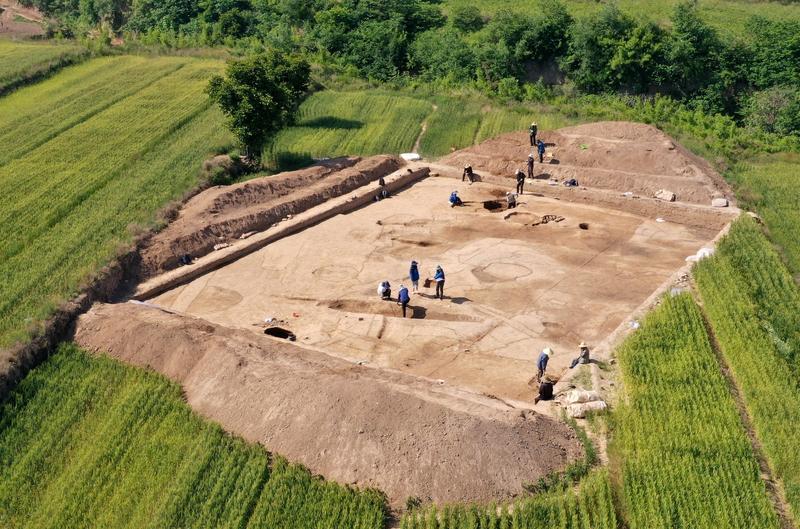 A bird's-eye view of Taosi site, located in Xiangfen county, Linfen, North China's Shanxi province. (LI XIANJUN / FOR CHINA DAILY)
A bird's-eye view of Taosi site, located in Xiangfen county, Linfen, North China's Shanxi province. (LI XIANJUN / FOR CHINA DAILY)
Editor's note: A national comprehensive research program, launched in 2002, to trace the origins of Chinese civilization, has led to the excavations and studies of key sites that are about 3,500 to 5,500 years old. It has revealed a host of secrets about ancient China, including how early civilizations were formed and how they merged to create unity in diversity. China Daily speaks to experts working at these sites to decode their recent discoveries.
More than six decades ago, a group of archaeologists descended on Taosi site in Xiangfen county, Linfen, North China's Shanxi province, looking for clues about the early phase of the Xia Dynasty (c.21st century-16th century BC), the first central dynasty recorded in Chinese history. While they did not exactly find what they wanted, they chanced upon something bigger and beyond their expectations.
Some of them are exquisite, some rarely seen before. The discoveries at Palace No 1 site will play a positive role in promoting studies about the origins of Chinese civilizations and about early China.
Gao Jiangtao, in charge of excavations at Taosi site in Linfen, Henan province
Stunning evidence of urbanization, including palaces, elite residential areas, cemeteries of the social elites, enceinte (fortified enclosures) and ceremonial centers, found since the first general survey of cultural relics in the 1950s, has earned the cluster of excavation sites a special mention in the annals of archaeology.
"Some scholars deemed Erlitou, (discovered in the late 1950s) in Central China's Henan province, the capital of the late Xia Dynasty," says He Nu, a researcher with the Chinese Academy of Social Sciences. "Hence, they were looking for evidence of the city in the dynasty's early phase."
Between 1978 and 1985, the CASS Institute of Archaeology and the Linfen cultural relics bureau teamed up for large-scale excavations at Taosi.
Residential areas for noblemen and commoners were discovered, as were tombs that preserve sacrificial items of the royal family, such as dragon-patterned plates and woodwork.
"These quickly catapulted Taosi site to the center stage," He says.
Archaeological studies that followed led to the incredible conclusion that the site was 4,300 years old and preceded the Xia Dynasty by a few hundred years. The city is believed to have spread over four square kilometers during the prosperous rule of Yao, a legendary ruler whose reign was believed to have started in the 23rd century BC.
Legends about Yao are found in Shiji, or Records of the Grand Historian, a monumental documentation of ancient China curated by Sima Qian during the first century BC.However, little archaeological proof about his rule existed until the excavations in Shanxi province in recent years.
"To some extent, Taosi site has helped prove that the era of Yao is not a figment of imagination," says Gao Jiangtao, who has been in charge of excavations at the prehistoric site for years.
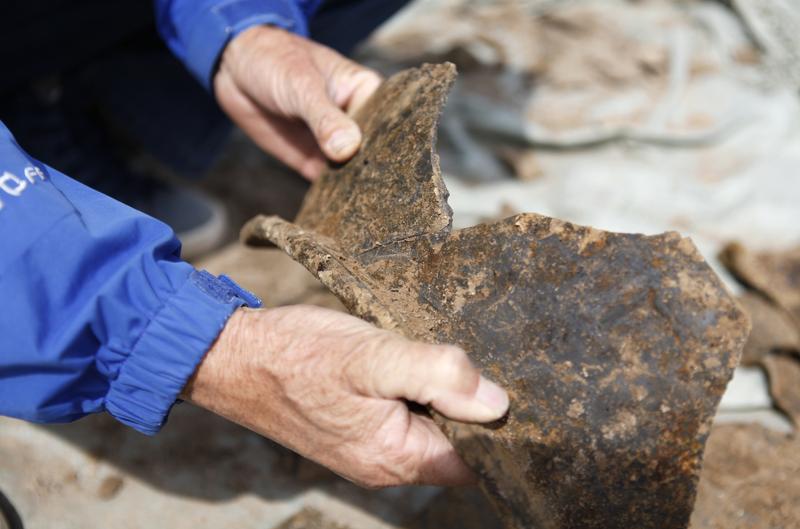 Pottery unearthed on Taosi site in Xiangfen county, Linfen, Shanxi province, in May. (LI XIANJUN / FOR CHINA DAILY)
Pottery unearthed on Taosi site in Xiangfen county, Linfen, Shanxi province, in May. (LI XIANJUN / FOR CHINA DAILY)
Taosi may have been the capital during the Yao era, but was abandoned around the 19th century BC. "The site has features that match what was documented by early Chinese historians," Gao says, adding that a lot still needs to be done to understand the era of Yao from a historical perspective.
The discovery of palace ruins, a storage house, tombs, astronomical platforms and a handicraft hub, among others, over the past four decades suggests that Taosi was as equipped as any ancient capital city.
Although archaeologists have unearthed other cities in China that are older than Taosi, few of them have monumental constructions and clear urban layouts like the latter does. The palaces have garnered the maximum academic attention. "They mirror the degree of civilization at that time and provide hints of cultural inheritance by following historical periods," Gao explains.
From 2013 to 2017, excavation work primarily shed light on the palace enclosure covering 130,000 square meters. "It is challenging to conduct an archaeological study of ancient architecture, as most structures are in ruins. Experts from various disciplines need to be involved to interpret signs and symbols. A high-level scientific approach must be applied," says Gao.
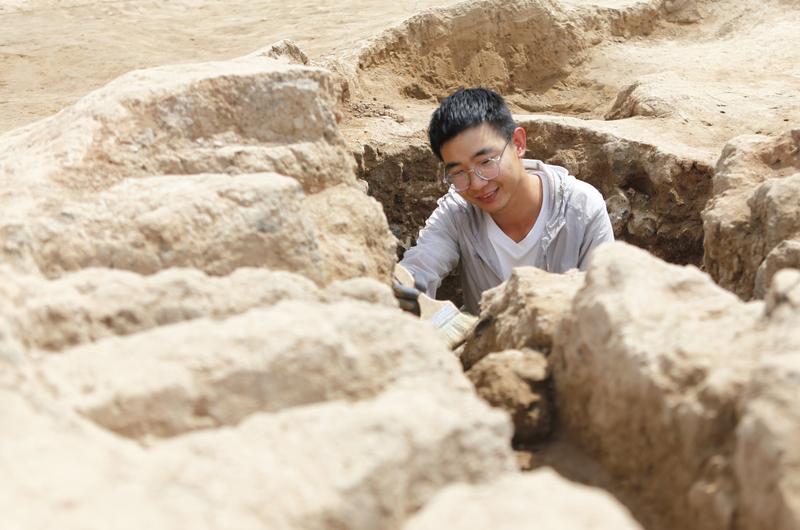 An archaeologist conducts excavation at Taosi site. (LI XIANJUN / FOR CHINA DAILY)
An archaeologist conducts excavation at Taosi site. (LI XIANJUN / FOR CHINA DAILY)
As many as 11 palaces are believed to have existed at the site in prehistoric times. "So far, we have finished work at the 'Palace No 1' site. We have basically figured out its scale, structure, layout, boundary and time span," Gao says.
These have been determined by extrapolation from the raised rammed-earth foundations, and everything else that has managed to stand the test of time, including pillars, he adds.
Work at Palace No 1 site started in March 2018 and was jointly conducted by the CASS Institute of Archaeology and the Shanxi provincial archaeology institute. It was finished earlier this year and archaeologists now have reasons to believe it covered an area of roughly 6,500 square meters.
"The palace was very grand in scale and boasted the biggest rammed-earth foundation," Gao says, adding that the main hall alone was 540 square meters in size, the largest of its kind in the Neolithic period, which in China refers to 10,000 to 4,000 years ago.
The whole structure was rectangular, a traditional palatial shape embraced over the course of history in China. "The layout was typical of Chinese palaces, with a main hall, adjoining buildings and corridors, a fortified enclosure and city gates. We even found application of the central axis concept, which was carried on by later generations," Gao says.
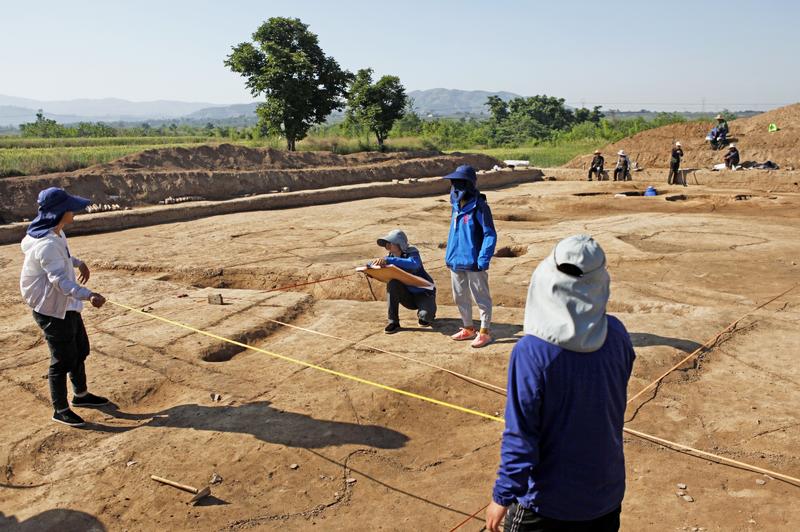 Archaeologists work on the site. (LI XIANJUN / FOR CHINA DAILY)
Archaeologists work on the site. (LI XIANJUN / FOR CHINA DAILY)
Intricate carvings and stamped patterns on the gray floor have corroborated earlier conjecture about the site having a palace.
More than 120 relics have been unearthed, including pottery, things made of animal bones, and jade and bronze wares.
"Some of them are exquisite, some rarely seen before. The discoveries at Palace No 1 site will play a positive role in promoting studies about the origins of Chinese civilizations and about early China," Gao says.
Early findings at the site included more than 1,000 tombs. These were unearthed before 1985 and were indicative of social stratification in ancient times.
In 2003, an observatory believed to have been built around the 21st century BC was found in Linfen.
It is proof of a highly developed civilization, preceding even Stonehenge (a prehistoric stone circle monument, cemetery and archaeological site near Salisbury in Wiltshire, England).
It is the earliest known observatory in the world with a mature calendar system, according to researcher He.
Then there is the free-standing, ceremonial gate tower that was discovered at the site in 2015.
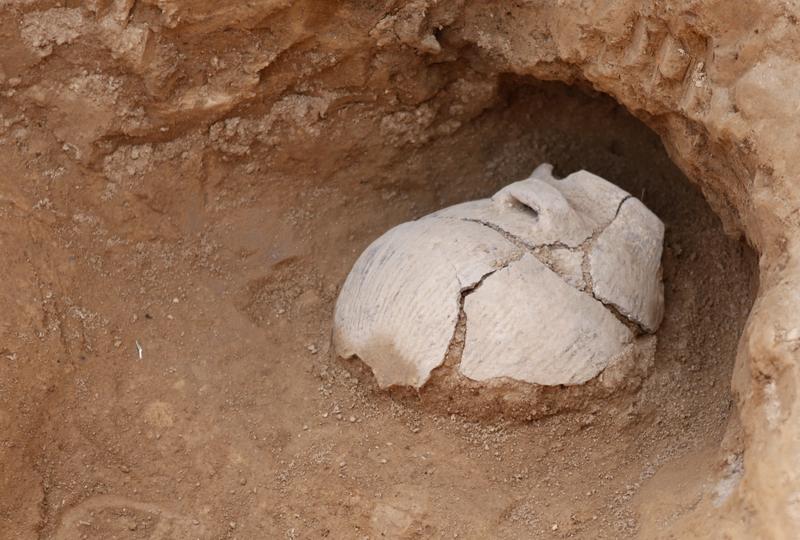 An earthenware jug found at the site in May. (LI XIANJUN / FOR CHINA DAILY)
An earthenware jug found at the site in May. (LI XIANJUN / FOR CHINA DAILY)
The structure resembles the entrance of the Forbidden City in Beijing.
Nevertheless, many experts associated with the project say more studies are necessary before coming to conclusions about the site.
Old history textbooks say the first Chinese dynasty belonged to Xia, who ruled from the 21st century BC, and may have descended from Yao's successors.
However, there is no archaeological evidence to support the theory yet.
Though similarities have been noticed between "character-like scripts" found at the site and "oracle-bone scripts" of later times, the formation process remains unclear, which calls for comprehensive and interdisciplinary research, experts say.
At the moment, Gao and his team are working at the Palace No 2 site that is located some 150 meters away from Palace No 1.
"From what we know so far, Palace No 2 was used for 100 years," Gao says.
Both palaces were built during the early stages of Taosi culture.
"We will study the other palaces one after another for the big picture," he adds.
Contact the writers at yangfeiyue@chinadaily.com.cn


